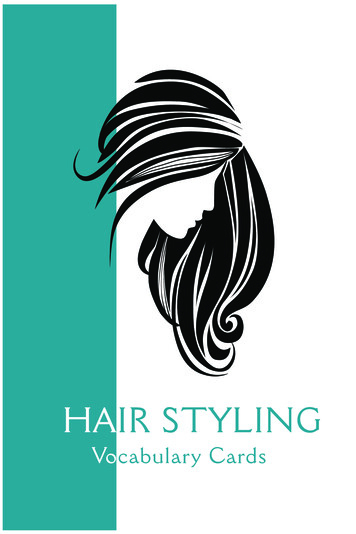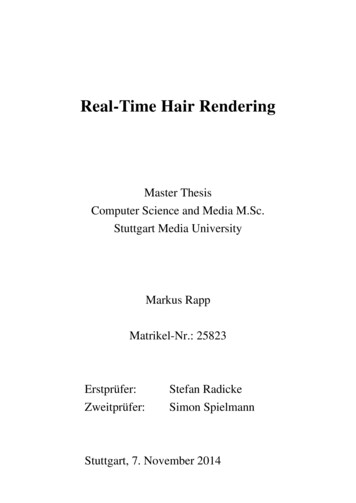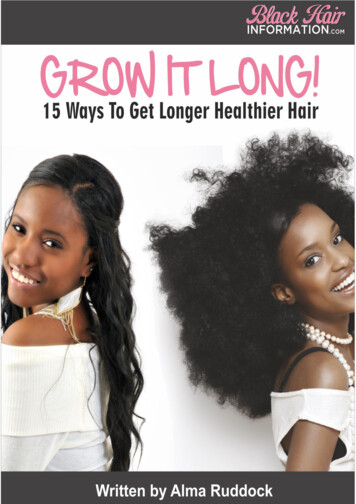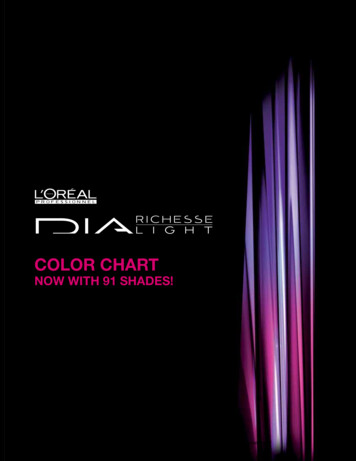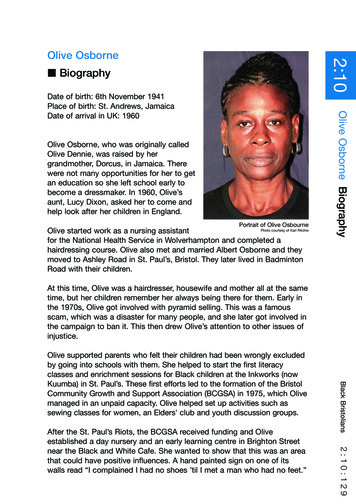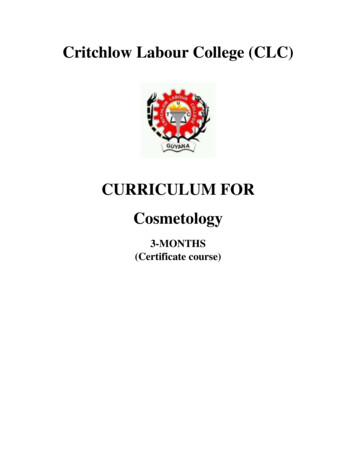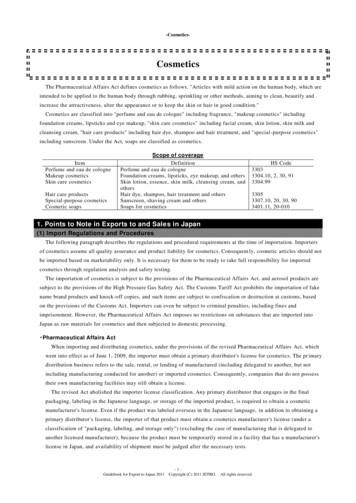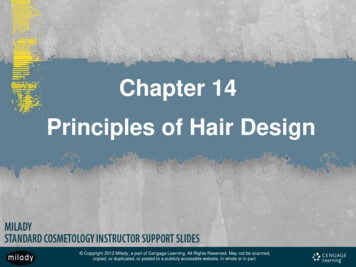
Transcription
Chapter 14Principles of Hair Design Copyright 2012 Milady, a part of Cengage Learning. All Rights Reserved. May not be scanned,copied, or duplicated, or posted to a publicly accessible website, in whole or in part.
“The optimist sees opportunity in everydanger; the pessimist sees danger inevery opportunity.”– Winston Churchill Copyright 2012 Milady, a part of Cengage Learning. All Rights Reserved. May not be scanned,copied, or duplicated, or posted to a publicly accessible website, in whole or in part.
Objectives Describe the possible sources of hair design inspiration. List the five elements of hair design. List the five principles of hair design. Copyright 2012 Milady, a part of Cengage Learning. All Rights Reserved. May not be scanned,copied, or duplicated, or posted to a publicly accessible website, in whole or in part.
Objectives (continued) Understand the influence of hair type on hairstyle. Identify different facial shapes and demonstrate how todesign hairstyles to enhance or camouflage facialfeatures. Explain design considerations for men. Copyright 2012 Milady, a part of Cengage Learning. All Rights Reserved. May not be scanned,copied, or duplicated, or posted to a publicly accessible website, in whole or in part.
Inspiration Inspiration: can come from anywhere at any time Visual understanding: what styles work best withdifferent face shapes Strong technique and skills: explore new possibilities;develop customized styles Copyright 2012 Milady, a part of Cengage Learning. All Rights Reserved. May not be scanned,copied, or duplicated, or posted to a publicly accessible website, in whole or in part.
Elements of Design: Lines Horizontal Diagonal Vertical Curved Copyright 2012 Milady, a part of Cengage Learning. All Rights Reserved. May not be scanned,copied, or duplicated, or posted to a publicly accessible website, in whole or in part.
Repeating Curved Lines Curved lines repeating in opposite directions to createa wave Copyright 2012 Milady, a part of Cengage Learning. All Rights Reserved. May not be scanned,copied, or duplicated, or posted to a publicly accessible website, in whole or in part.
Designing with Lines Single line Parallel lines Copyright 2012 Milady, a part of Cengage Learning. All Rights Reserved. May not be scanned,copied, or duplicated, or posted to a publicly accessible website, in whole or in part.
Designing with Lines (continued) Contrasting lines Transitional lines Directional lines (forward orbackward movement) Copyright 2012 Milady, a part of Cengage Learning. All Rights Reserved. May not be scanned,copied, or duplicated, or posted to a publicly accessible website, in whole or in part.
Designing with Lines (continued) Form: outline or silhouette of the style Space: area surrounding the form orarea the hairstyle occupies Copyright 2012 Milady, a part of Cengage Learning. All Rights Reserved. May not be scanned,copied, or duplicated, or posted to a publicly accessible website, in whole or in part.
Design Texture and Tools Styling tools Chemicals Designing with wavepatterns Copyright 2012 Milady, a part of Cengage Learning. All Rights Reserved. May not be scanned,copied, or duplicated, or posted to a publicly accessible website, in whole or in part.
Color Color psychology (creates texture and lines, ties designelements together, evokes reactions) Creating dimension with color (warm colors createvolume, cool colors recede) Copyright 2012 Milady, a part of Cengage Learning. All Rights Reserved. May not be scanned,copied, or duplicated, or posted to a publicly accessible website, in whole or in part.
Lines and Tones Creating lines with color (colorcan attract the eye) Color selection (tone should becompatible with skin tone). Copyright 2012 Milady, a part of Cengage Learning. All Rights Reserved. May not be scanned,copied, or duplicated, or posted to a publicly accessible website, in whole or in part.
Proportion Proportion: Relationship betweenobjects relative to their size Body proportion (hair and bodyportion must be compatible) Copyright 2012 Milady, a part of Cengage Learning. All Rights Reserved. May not be scanned,copied, or duplicated, or posted to a publicly accessible website, in whole or in part.
Balance Symmetrical Asymmetrical Copyright 2012 Milady, a part of Cengage Learning. All Rights Reserved. May not be scanned,copied, or duplicated, or posted to a publicly accessible website, in whole or in part.
Rhythm The regular, recurrent pattern of movement in a style Copyright 2012 Milady, a part of Cengage Learning. All Rights Reserved. May not be scanned,copied, or duplicated, or posted to a publicly accessible website, in whole or in part.
Emphasis Wave patterns Change in form Color Ornamentation Copyright 2012 Milady, a part of Cengage Learning. All Rights Reserved. May not be scanned,copied, or duplicated, or posted to a publicly accessible website, in whole or in part.
Harmony The most important principle in hair design; the orderlyand pleasing arrangement of shapes and lines– Form with interesting lines– Pleasing color and textures– Balance and rhythm to strengthen design Copyright 2012 Milady, a part of Cengage Learning. All Rights Reserved. May not be scanned,copied, or duplicated, or posted to a publicly accessible website, in whole or in part.
Physical Characteristics Shape of head Features Body posture Influence of hair types– Texture Copyright 2012 Milady, a part of Cengage Learning. All Rights Reserved. May not be scanned,copied, or duplicated, or posted to a publicly accessible website, in whole or in part.
Guidelines for Hair Types Fine, straight hair (no body or volume) Straight, medium hair (more versatility in styling) Straight, coarse hair (hard to curl and carries morevolume) Copyright 2012 Milady, a part of Cengage Learning. All Rights Reserved. May not be scanned,copied, or duplicated, or posted to a publicly accessible website, in whole or in part.
Guidelines for Hair Types (continued) Wavy, fine hair (looks fuller with layering) Wavy, medium hair (offers most versatility) Wavy, coarse hair (can appear unruly if not shapedproperly) Copyright 2012 Milady, a part of Cengage Learning. All Rights Reserved. May not be scanned,copied, or duplicated, or posted to a publicly accessible website, in whole or in part.
Guidelines for Hair Types (continued) Curly, fine hair (responds well to mild relaxers) Curly, medium hair (creates a wide silhouette) Curly, coarse hair (needs heavy styling products) Copyright 2012 Milady, a part of Cengage Learning. All Rights Reserved. May not be scanned,copied, or duplicated, or posted to a publicly accessible website, in whole or in part.
Guidelines for Hair Types (continued) Very curly, fine hair (best cut short) Extremely curly, medium hair (chemical relaxers and hairpressing are good options) Extremely curly, coarse hair (chemical relaxingrecommended with other thermal services) Copyright 2012 Milady, a part of Cengage Learning. All Rights Reserved. May not be scanned,copied, or duplicated, or posted to a publicly accessible website, in whole or in part.
Facial Types Oval Square Round Copyright 2012 Milady, a part of Cengage Learning. All Rights Reserved. May not be scanned,copied, or duplicated, or posted to a publicly accessible website, in whole or in part.
Facial Types (continued) Triangular Diamond Oblong Inverted triangle Copyright 2012 Milady, a part of Cengage Learning. All Rights Reserved. May not be scanned,copied, or duplicated, or posted to a publicly accessible website, in whole or in part.
Facial Profile Straight profile Convex profile Concave profile Copyright 2012 Milady, a part of Cengage Learning. All Rights Reserved. May not be scanned,copied, or duplicated, or posted to a publicly accessible website, in whole or in part.
Special Considerations:Top Third of Face Wide forehead Receding forehead Narrow forehead Large forehead Copyright 2012 Milady, a part of Cengage Learning. All Rights Reserved. May not be scanned,copied, or duplicated, or posted to a publicly accessible website, in whole or in part.
Middle Third of Face Close-set eyes Crooked nose Wide-set eyes Wide, flat nose Copyright 2012 Milady, a part of Cengage Learning. All Rights Reserved. May not be scanned,copied, or duplicated, or posted to a publicly accessible website, in whole or in part.
Middle Third of Face (continued) Long, narrow nose Small nose Prominent nose Copyright 2012 Milady, a part of Cengage Learning. All Rights Reserved. May not be scanned,copied, or duplicated, or posted to a publicly accessible website, in whole or in part.
Lower Third of Face Round jaw Square jaw Long jaw Copyright 2012 Milady, a part of Cengage Learning. All Rights Reserved. May not be scanned,copied, or duplicated, or posted to a publicly accessible website, in whole or in part.
Lower Third of Face (continued) Receding chin Small chin Large chin Copyright 2012 Milady, a part of Cengage Learning. All Rights Reserved. May not be scanned,copied, or duplicated, or posted to a publicly accessible website, in whole or in part.
Head Shapes Not all are round Design for volume and lack of volume Copyright 2012 Milady, a part of Cengage Learning. All Rights Reserved. May not be scanned,copied, or duplicated, or posted to a publicly accessible website, in whole or in part.
Styling for Eyeglasses Consider eyeglass arms. Consider hair length around ear. Copyright 2012 Milady, a part of Cengage Learning. All Rights Reserved. May not be scanned,copied, or duplicated, or posted to a publicly accessible website, in whole or in part.
Hair Parts and Fringe Triangular Diagonal Curved Copyright 2012 Milady, a part of Cengage Learning. All Rights Reserved. May not be scanned,copied, or duplicated, or posted to a publicly accessible website, in whole or in part.
Style Parts Center Diagonal Side Zigzag Copyright 2012 Milady, a part of Cengage Learning. All Rights Reserved. May not be scanned,copied, or duplicated, or posted to a publicly accessible website, in whole or in part.
Designing for Men Styles Mustache and beard shapes Copyright 2012 Milady, a part of Cengage Learning. All Rights Reserved. May not be scanned,copied, or duplicated, or posted to a publicly accessible website, in whole or in part.
Summary and Review What are some of the possible sources a hair designermight use for inspiration? What are the five elements of hair design? What are the five principles of hair design? What influence does hair type have on hairstyle? Copyright 2012 Milady, a part of Cengage Learning. All Rights Reserved. May not be scanned,copied, or duplicated, or posted to a publicly accessible website, in whole or in part.
Summary and Review (continued) List and describe the seven facial shapes and explainhow hair design can be used to highlight or camouflagefacial features. How do the elements and principles of hair design applyto men? Copyright 2012 Milady, a part of Cengage Learning. All Rights Reserved. May not be scanned,copied, or duplicated, or posted to a publicly accessible website, in whole or in part.
Congratulations!You have completed one unit of studytoward course completion. Copyright 2012 Milady, a part of Cengage Learning. All Rights Reserved. May not be scanned,copied, or duplicated, or posted to a publicly accessible website, in whole or in part.
Copyright 2012 Milady, a part of Cengage Learning. All Rights Reserved. May not be scanned, Title: PowerPoint

